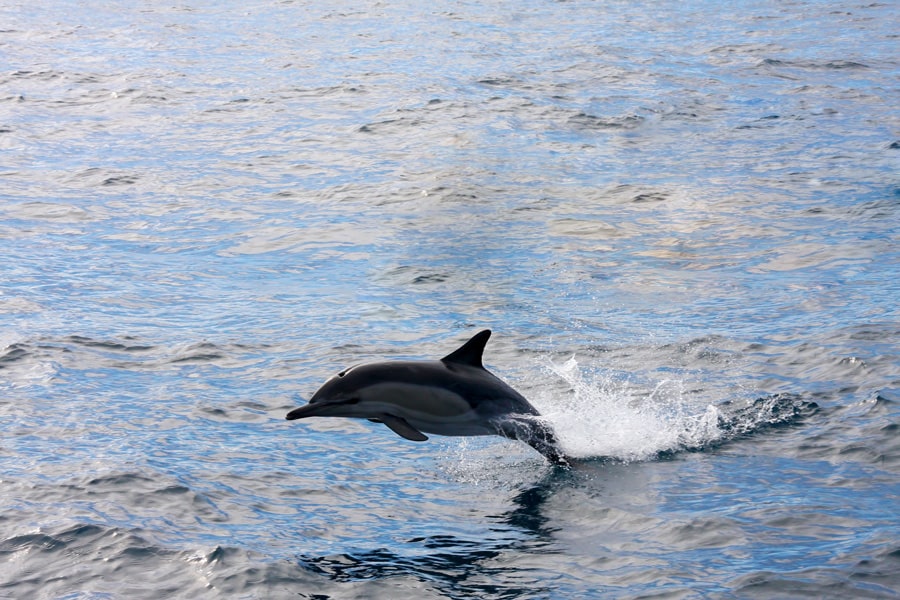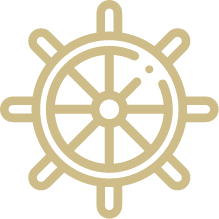
- Blog
-
by Pete Green
Delivering dreams
Working as a yacht delivery skipper for Halcyon Yachts can never be described as dull. Until the Coronavirus lockdowns, they’ve kept me very busy with some exceptional trips with destinations all over the globe, from Bora Bora, to the Baltic and from Mexico to the Med.
When a call came in to fit in a quick delivery between two already confirmed jobs, I took it on, thinking it would be a straightforward 6-day trip. This is not how things turned out!
The job was to deliver a Halmatic Butler 40 foot Motor Yacht from the southern Tunisian town of Monastir, to Amerimar on Spain’s Mediterranean coast northeast of Malaga.
Before finalising the job, I made my usual pre-confirmation call to the owner to introduce myself and my team and to discuss the delivery and the vessel. For all my yacht deliveries, there is inevitably a back story, but this one immediately stood out.
A well-founded vessel
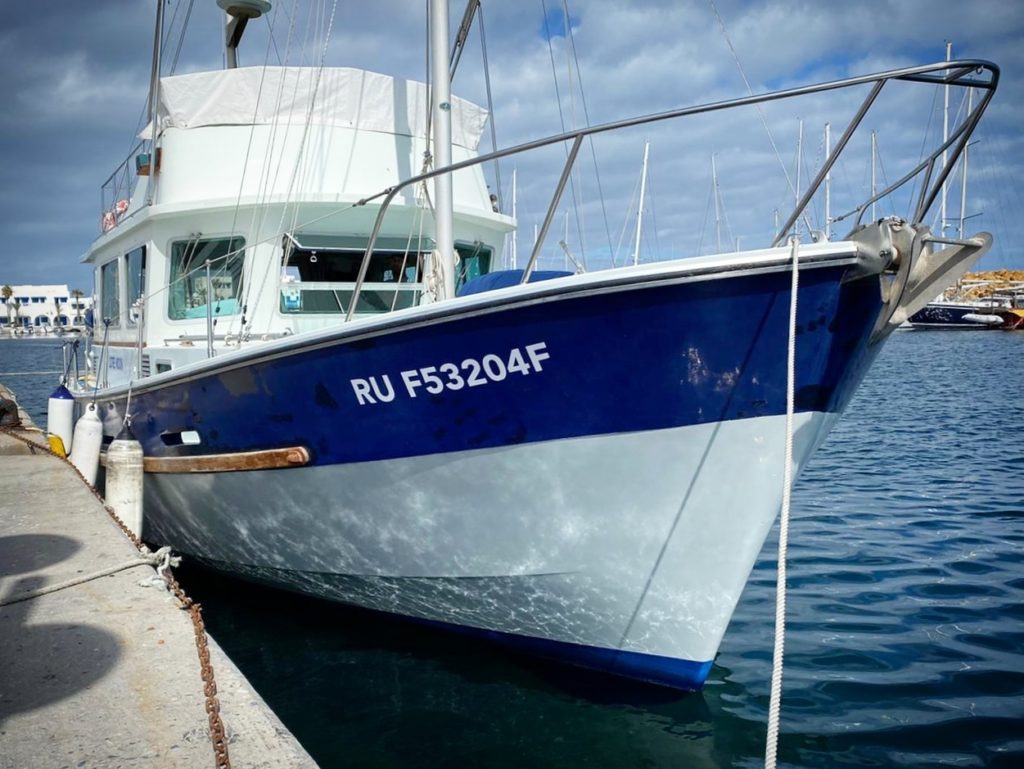
“Otters Moon” was built in 1979 in Emsworth for the owner of Clyde Marine. As a Master Mariner and owner of several successful commercial vessels, he knew what he was looking for. This was to be a family boat, capable of navigating the islands and waterways of Northern Scotland safely and comfortably. It was fitted out with radar, SSB radio and the latest trusted electronics available at the time. She sported a superb pilothouse, akin to those found on offshore supply and fishing vessels, with clear 360 degree views and excellent protection from the elements.
The engine specified was a Gardner straight 6, 10.5 litre 6LXB – a marinised version of the beautifully simple and strong engine popular in Fire Engines, buses and similar hard-working vehicles. The vessel also boasted a fuel capacity of 4500 litres and with the “lump” purring away at 800 rpm, gave a cruising speed of 6 knots, consumption of 6 litres per hour and consequently, a comfortable range in excess of 4000 NM!
Otters Moon proudly flew a Blue ensign, with the owner being a member of the Royal Scottish Motor yacht Club and had spent many years doing just what she was built for, creating a perfect base for family holidays cruising the beautiful and often remote Scottish islands with family and friends aboard in snug and secure safety, regardless of the vagaries of the Scottish weather.
Sadly, after a period of ill health, the original owner had passed away around three years ago and his son sold her to a Breton, who had spent much of his working life with his brother, between Lorient in Brittany and Reunion Island where Otters Moon was re-registered as Lotre Moun.
A change of mind
As soon as he sold her, he immediately regretted his decision and it played heavily on his mind until around six months ago when he contacted the new owner to advise he wanted to buy her back.
Negotiations took some time, as the boat was now located in Tunisia and flagged outside of Europe, causing further complications. Eventually, a deal was finalised and Halcyon (and myself) were contracted to complete the legalities of the sale and get the boat back to Europe in Almerimar.
After my call to the original owners’ son, I was reassured to hear the history of the boat and advised that the engine had just been serviced so, after covering a number of other details off, agreed to take the delivery on.
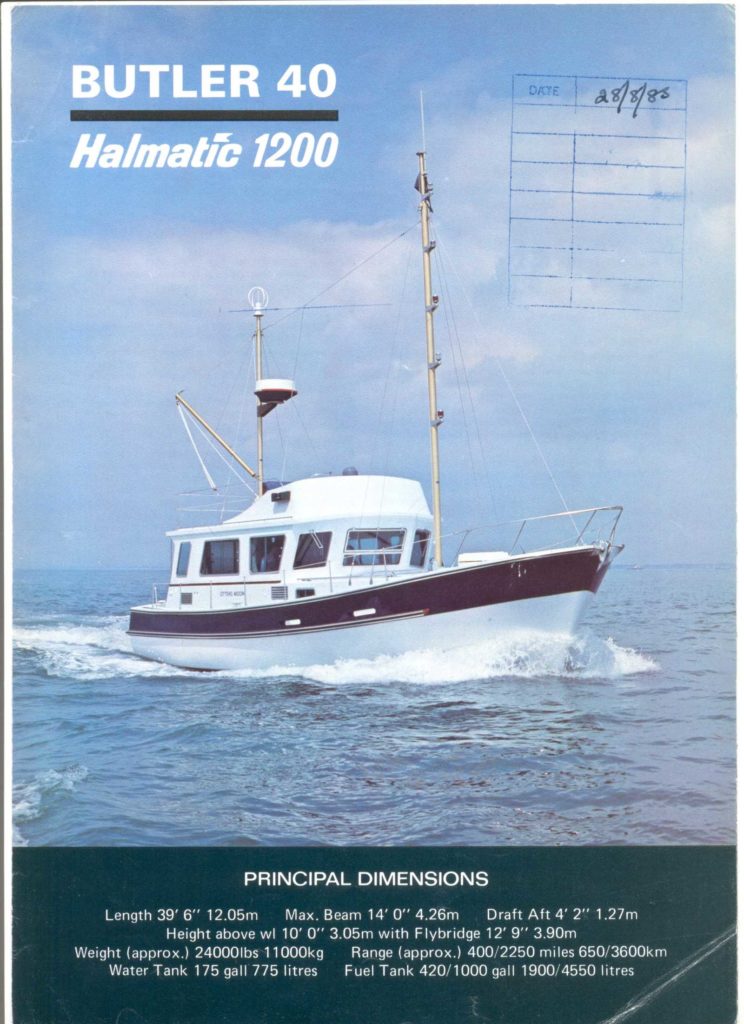
I had a two-week time slot for the delivery before my next job and with approximately 800 miles to cover from Tunisia, with options to go via Sardinia and the Balearics, it looked on paper to be quite straight forward.
Best laid plans of mice
As usual, straight forward trips on a chart inevitably never turn out to be so, particularly once you consider the weather and other external factors. The lack of suitable ports of refuge along the Algerian coast and Noonsite advising “Visits by cruising yachts cannot be recommended”! meant that the direct route carried some increased risk, particularly as we were running on an older, single-engine vessel. It turned out that this was to be the least of our challenges!
As always, Halcyon select their teams carefully for their deliveries. My crew were both commercially endorsed Yacht Masters, 1 having lots of windsurfing experience and his own boat kept on the Scottish West Coast, the other being a professional Marine Engineer as well as a Charter Skipper. A dream team for this trip.
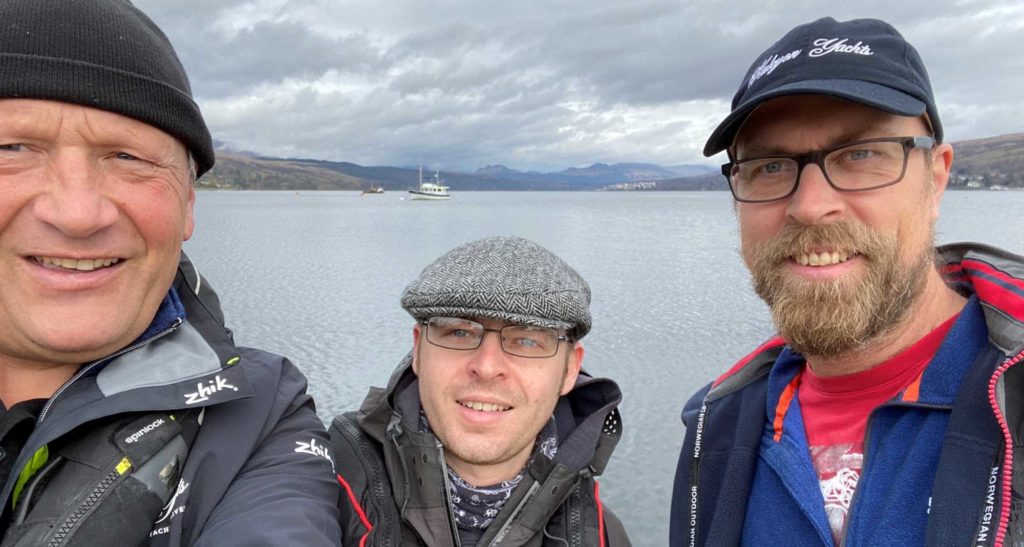
I called my crew to get acquainted and agreed pre-departure tasks and best options for travel to the boat. I had already spoken with the very helpful team at Gardner and agreed with them and the owner, to take out a sensible service kit for the engine as a precaution, including filters, seals etc. As we were confirming flights, we got the news that the regional airline FlyBe had gone into administration. One of my crew lived on the Scottish West Coast, close to the Clyde (the original home of Otters Moun).
His original plans to fly from Glasgow were now out of the window, so we elected for him to drive down and join me for a morning flight from Gatwick to Tunis.
My other crew member was travelling from the Southampton area so theoretically we could share the same flight and transfer in Tunisia. Sadly, my second crew was delayed and just missed the flight, so had to rebook with a more convoluted schedule, arriving to the boat eventually just after midnight.
Departing from the UK on 9 March, we were already aware of the rapidly changing situation globally with Corona Virus lockdowns being well established in China and things rapidly deteriorating in Italy and Spain.
On arrival to Tunis Airport, we witnessed hurriedly put together systems for screening passengers, with new forms advising of intended movements, Temperature checks for all passengers and other controls were also in place. There was also a sense of heightened security in place, due to a suicide bombing at the US Embassy in the past few days. We had organised a private transfer for the two-hour ride south to Marina Monastir and our driver proved to be exceptionally helpful and professional.
Let’s get acquainted
We arrived at the Marina before dark where we met the vendor. He was retired and his brother was also in the Marina with his sailboat. We went through some of the boat basics and agreed on a schedule to go over more details and the formalities of the sale and took their recommendation of dining in one of the superb restaurants in the marina complex before turning in for the night.
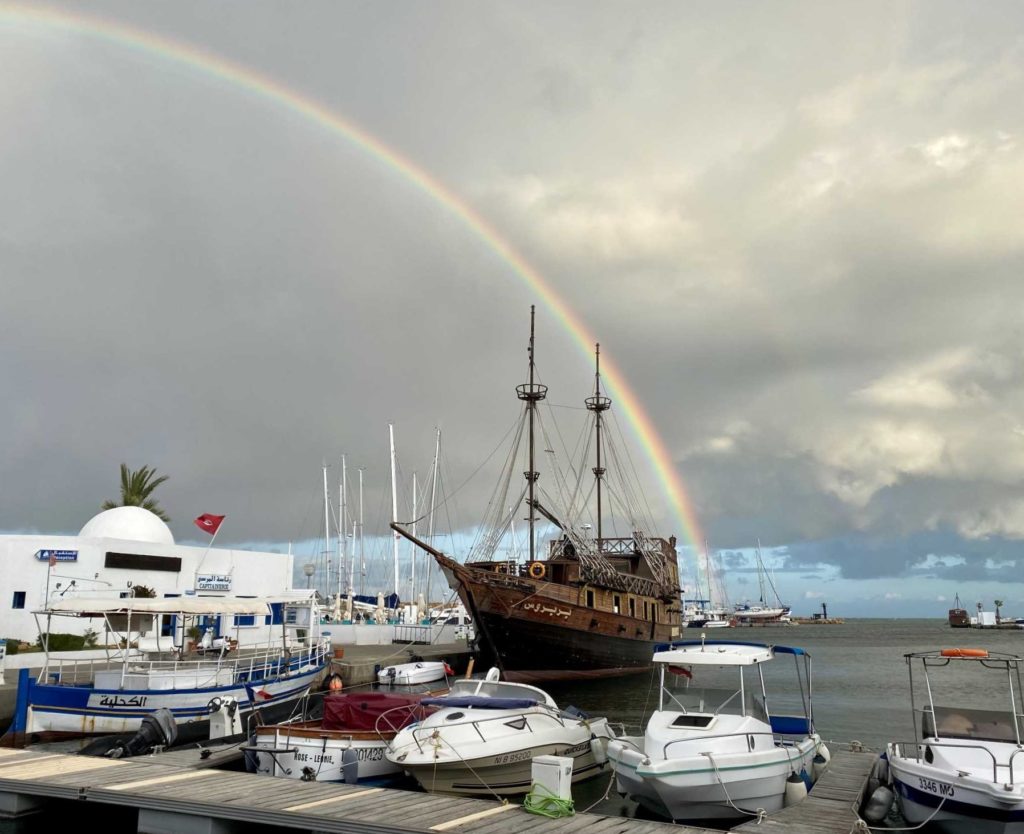
The following day we spent going through the boat, from bow to stern, checking and recording any issues we found and getting to understand the boat in detail with the vendor and his brother’s help. As with all my deliveries, I allow plenty of time for this process as it’s vital to identify any potential issues before we head out.
Even though the engine had just been serviced, we found that the engine required fluid top-ups, alternator belt tension adjusting, fuel injector leaks fixing and various other minor errors resolving. Fortunately, I had made sure I came with all the engine spares I needed, as well as the tools and know-how between myself and the crew to carry out this work swiftly and effectively.
Phone Connectivity in Tunisia is very expensive on UK roaming tariffs, so we made use of local Wi-Fi in the marina restaurants (in exchange for a coffee or food), to keep the owner and head office informed of progress and to finalise plans for the trip.
Weather in Northern Europe this winter had been dominated by an almost weekly series of low pressures and a more southerly jet stream, causing flooding and storm damage over wide areas. We had been observing the weather for another yacht delivery in Northern Europe for some time by now and were painfully aware of these frequent lows traversing the north Atlantic, as well as the high pressure in Biscay and low in the Gulf of Genoa, assisting the Mistral winds to flow southeastwards from the Gulf of Leon.
Having seen a window to move the boat before the next Mistral would affect this delivery we were pleased to see that conditions would remain relatively favourable in the Southern part of the Mediterranean.
With a day set aside for boat sales and another for victualing and other formalities, we set our sights on departing Monastir on the morning of 12 March.
Marina Monastir is a pleasant place and I bumped into some owners who I had been previously acquainted with.
There was a general concern amongst the cruising community based here, that their plans were having to be rapidly changed, as the news of increasing cases of the virus and consequential lockdowns were being put into place.
I was comfortable with the boat and crew and we focused our energies on ensuring our passage plan was viable. I had already raised concerns about stopping in obvious on route destinations of Sardinia and the Balearic’s, but as news came in of the increased numbers of cases of COVID-19 and the weather window with a new Mistral being forecast to start around 4 days after we were due to depart, I now made plans for a direct 800NM passage to Almerimar, with options to stop over the first day or so, along the Northern Tunisian coast if we ran into any difficulties.
Departure before lockdown
We provisioned fuel accordingly (fuel euro 50 cents per litre!) and after completing departure formalities, we were ushered out of the marina by the port police before 9 am on 12 March.
Once clear of the marina, we set Lotre Moun on a northerly path to clear the various fishing systems in light winds and with little swell. It was great to be moving at last and the boats pleasant rolling movement set up the rhythm for the journey ahead.
We had agreed on a three-hour watch system and with the autopilot working well, we chugged away at a pleasant 800rpm and steady 6 knots. The watch system we had set, allowed for plenty of rest, as well as a schedule for cooking meals. Through the night we navigated close to the coast at Ras At Tib (Cape Bon), so that we could get updated reports on travel restrictions before heading across the Gulf of Tunis.
We were frequently hailed by the Tunisian Coastguard and Navy to check on our intentions during the first 36 hours or so whilst we were in Tunisian Waters, but the communications were brief and courteous. Watches were generally quiet, with very few vessels around.
Things that glow in the night
We did come across various fishing vessels, including a squid fleet close to shore off Ras At Tib. I was off watch at the time and the crew on watch woke me to ask me what I made of the strange glow he saw over the horizon. After a quick check on the charts and radar, I advised that it was most likely a squid fleet and as we came within 5 miles, this proved to be the case.
On the whole, the route we chose was in deep waters, clear of obstructions and hazards, traffic and the main shipping lanes. Our route from the north of Tunisia took us inshore of the traffic separation schemes, with a few degrees North of East, which took us purposely close to the Galite Islands, 24 miles off the coast of Tunisia and close to the Algerian border.
As suspected, naval and coastguard activity remained particularly intense for this part of the passage. We were transmitting on AIS (class B), so for the most part, we were left to continue without radio contact.
Now running south of the main shipping lanes for the next few days, our route kept us clear of coastal fishing activity and firmly in international waters. Our distance offshore varied as the undulating mountainous Algerian coast came in and out of view.
The weather for the first few days was just as forecast, with light winds mainly from astern and an increased swell being generated by the Mistral as it set in 100s of miles to the North. Halcyon Yachts have various communication systems set up, and whilst offshore we were updating our position regularly on Inmarsat.
Adjusting our course
As we passed the halfway point around 50nm off El Jazair, we received an Inmarsat text message from Halcyon Yachts advising of the closure of borders in Spain, Algeria and Morocco and that we should continue west whilst a new program was formulated. Our offshore position off El Jazair was our planned point of departure from North African waters, to make the crossing to Spain.
We made European landfall during our fourth night, close to La Manga and with steadily increasing winds from the E/NE as forecast, we were grateful for the shelter the Sierra Nevada and rugged Spanish coastline provided, as well as the ability to communicate freely on our phones, using our UK roaming services.
Halcyon Yachts’ shore team in the UK confirmed that the original plans to deliver to Almerimar were no longer a sensible option and after various discussions with my crew, we agreed that we would continue towards Gibraltar.
A Greek tragedy
Whilst I was on watch in the early hours as we passed the vast plastic-covered coast of Almerimar, I listened on the VHF to a conversation between two Greek registered leisure vessels and the Spanish Coast Guard. The boats had just returned to European waters from the Caribbean and were wanting permission to enter Almerimar as they had apparently been refused entry to Gibraltar and were running very low on food, fuel and water.
It was sobering to hear the exchanges between the coast guard and one of the vessels’ crew. They were advised that it was illegal to enter and if they did, they would be arrested and impounded. After some extended communications, the Greek vessels elected to enter as they were concerned for their safety and required port of refuge.
As the day progressed, we were advised by head office that, under our commercial papers, we would be allowed to refuel in Gibraltar under quarantine. We were also delighted to hear that another Halcyon Yachts delivery skipper and crew were in Gibraltar and that they would be happy to provision for us so that we could continue directly all the way back to the Clyde, where the owner had ultimately intended to bring Otters moon back to but had now confirmed that this was the best option in the circumstances.
New Mission
Whilst not on any of our agendas, we soon realigned our thoughts and plans for this new assignment. Now also able to receive detailed weather routing information, it was clear that for the last 24 hours along the Spanish coast, we were in for quite a blow, with building seas as the Mistral in the Gulf of Leon, spread its tentacles into the Alboran Sea causing a strong Levant wind to blow from the E/NE.
As there was hardly any leisure vessels about due to the growing restrictions, I elected to take a familiar inshore route, thus avoiding the worst of the waves, winds and swell. This proved prudent and we had a fast and safe passage all the way through to Sotogrande.
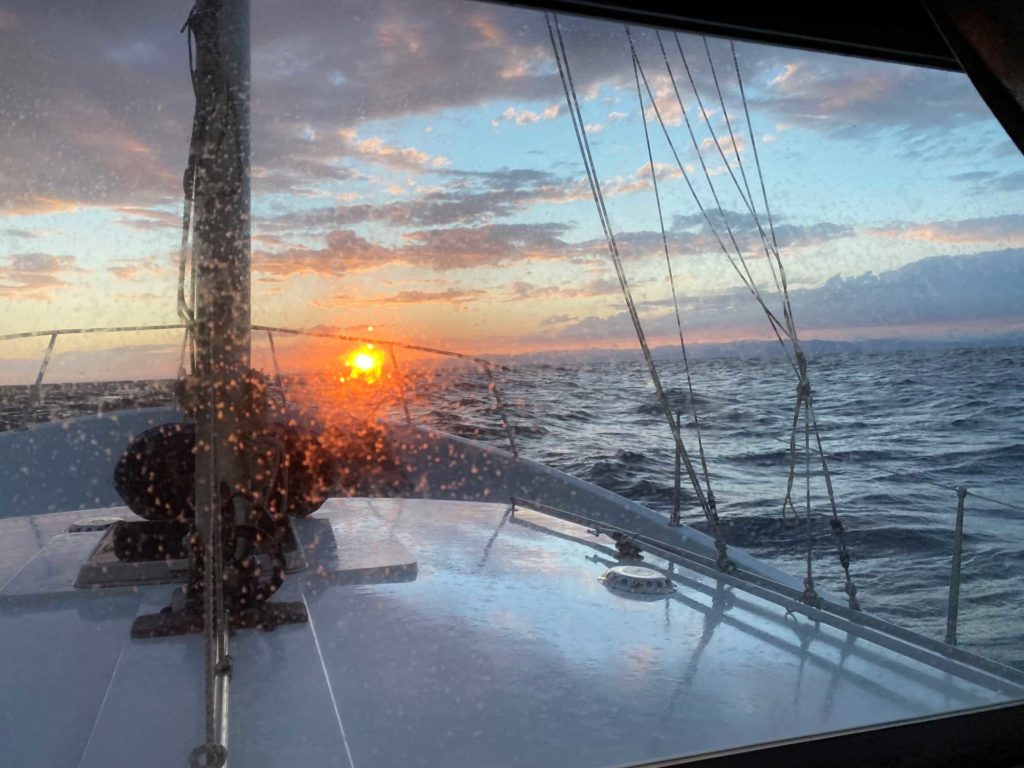
The boat had been well prepared for an offshore passage at the beginning of the trip in Monastir. Our regular checks en route had ensured that we would be secure for the final exposed part of this trip between Estopona and Europa Point, before we ducked in behind Gibraltar for the safe haven of its Marinas.
As I had travelled this route and entered Gibraltar before many times, I was not particularly concerned of our ETA off Europa Point around 01:00hrs.
We knew we would be in for an interesting ride with strong winds and 3m swell forecast and Europa point did not disappoint as we hand steered with all hands in the wheelhouse for the last two hours.
The Rock
After clearing with Gibraltar VTS and coastguard, we finally tied up in a deserted Gibraltar alongside around 3.30 am. Having covered approximately 900 nm in around 5 days, we went straight to sleep and rested well.
I was woken at around 08:30 by our Halcyon Yachts shore crew. They could see our quarantine flag and masts over the walls but were unable to access and so we arranged for delivery of supplies through the fuel station.
After some gratefully received bacon sandwiches, we learnt that this other Halcyon crew had only just made it through to Gibraltar. Their delivery from the Canaries to Denia had been similarly curtailed and just before the borders closed, they had managed to leave the boat in La Linea and crossed into Gibraltar by foot where they had been waiting for return flights to the UK.
We were very grateful for the supplies and the understanding of the fuel operators and authorities. They allowed us to stay another night, which gave sufficient time for us to carry out a service on the engine, thorough checks of the boat and a proper rest and preplanning before we pushed on into the Atlantic.
One more unto the breach
Leaving early in the morning on the 19th, With the Levante wind at its full force, I knew we were again, in for an interesting ride until the night fell. Indeed, this was the case. Fortunately we were running from the wind and with a sea of around 3m and a 13-second interval, we made very fast progress on the northern inshore passage through the Gibraltar straits. By now, we had built a lot of confidence in Lotre Moun’s abilities and she comfortably handled these conditions, allowing us to function without drama on board.
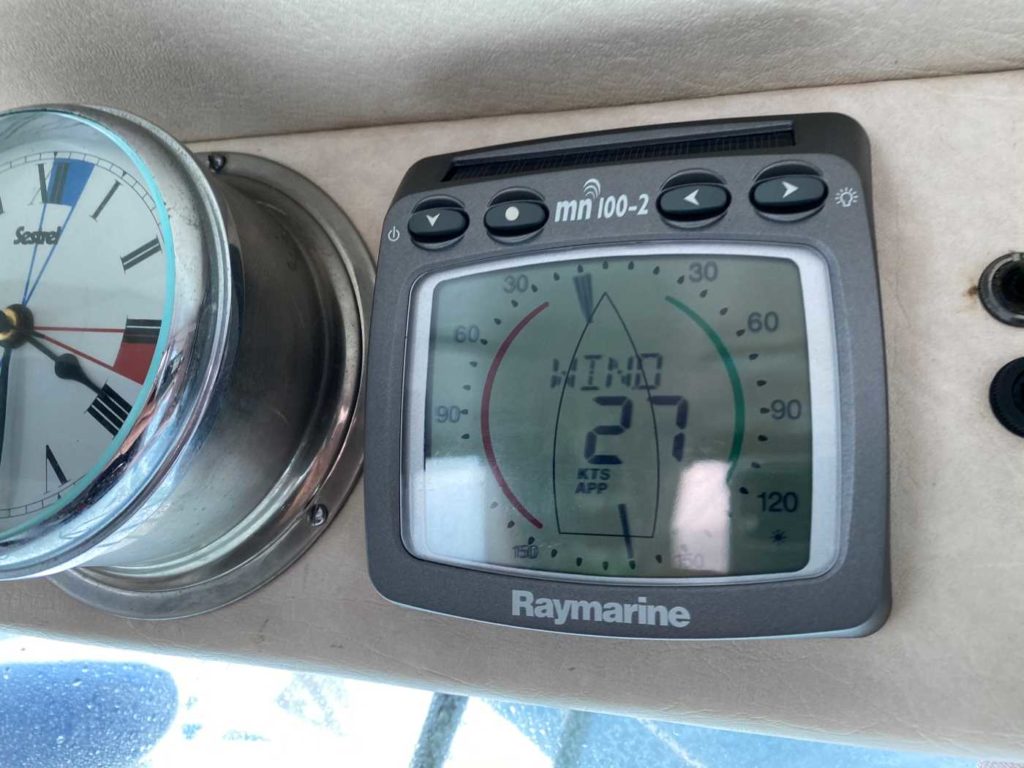
We flew past Tarifa, again with minimum traffic and on into the night for the offshore stretch between Trafalgar and the Portuguese Algarve. These coasts are so beautiful and with clear skies pretty much all the way from Tunisia, we felt a sense of sadness that we were unable to enjoy them more. But this was not our mission and keen to get the job done, we focused on keeping Lotre Moun on course and running happily.
Rounding the big corner
Passing Cabo Sao Vicente on the south-western corner of Portugal just before dark, we made the big turn from West to North and with a dying effect from wind and waves from the Levante, we had a day of calm seas as we made towards Cascais.
A less welcome issue for our watches from Cabo Sao Vicente North, was the frequent sight of the notorious fishing pots, often marked with black markers.
Keeping further offshore, outside of the 100m contour helps to avoid these during the night when they are otherwise impossible to spot. Fortunately, Lotre Moun sports a fully protected prop and rudder. This meant that on the two occasions we thought we may have come into contact with fishing pot markers, they harmlessly slipped past us causing no damage or loss.
We closed Cascais just before dark the following evening and with the wind slowly setting from the North, we elected to give my crew a quick familiarisation circuit of the anchorage in Cascais before, heading back around the corner of Cabo Raso. The sunset was again perfect, illuminating the palace at Sintra in the hills above the cape. Once again we were joined by Dolphins, which had been a feature at various points along the way so far and would continue to be a feature on our journey north.
Beautiful Galicia
As our engine had to be allowed to cool completely before we could check fluids, I planned to make an overnight stop on anchor in the protected Ria de Vigo.
All along the northern part of the Portuguese coast, we had increasing swell and winds from a low-pressure system to the North of Biscay and we needed time for this to pass to ensure we had a safe window to cross Biscay.
We crossed back into Spanish waters and the dramatic entrance to the Ria de Vigo at the Galician Cabo Silleiro just after dawn and spoke with the VIGO VTS operator and Spanish Coastguard to advise our intentions.
The operator couldn’t have been more polite and helpful, understanding our predicament and agreeing for us to anchor off the beautiful barrier island of the bay, the Islas Cies.
On anchoring, we all took a well-earned nap, waking up before dark to carry out the checks we needed to do on the boat and engine.
We felt very blessed to be allowed to visit these locations, with no-one else around and in perfect weather. I even managed to jump into the chilly water for my first swim of the trip!
Steering issues
The weather forecast north, gave a tight window for crossing Biscay before a strong and short-lived Easterly in the English Channel, backed and became an untenable northerly in the Irish Sea. We therefore pressed on early into a 20knot NNE which took us into the night off the next great cape en route – Finisterre.
Although part of the original installation and now over 40 years old, whilst rudimentary compared to modern Autopilots, our Decca 150 Pilot had proven to be reliable in all but the strongest conditions. Just before we cleared the Illas Sagres (to the south of Finisterre) however, in the black of night and with large seas and force 6 northerlies, the pilot failed, steering the boat hard to starboard. I tentatively tried to reset it but on the second attempt, I gave up and elected to hand steer until the change of watch.
On inspection we found two broken transistors within the unit and also noticed some free play in the runner which we had not noticed before. Further investigations of the steering at first light confirmed that whilst there was nothing major failed thus far, the play was inside the runner stock and suspected to be caused by a worn keyway.
As with all systems on Lotre Moun, the steering was simple to access and was built “belt and braces”.
After thorough investigations and discussions with head office and the owner, I felt the play in the steering was not a game changer and therefore, was comfortable that we could continue, so increased speed and entered Biscay in dying winds with a course set for the Ile D’Oussant some 300 miles to the North East.
Biscay Beacons
We changed the watches to two-hour watches, to allow for hand steering and for the first day into Biscay, we had to work hard for our miles north. Seas were quite confused and Lotre Moun was not happy for the first time.
At one point during the first morning into the crossing, some 30 miles off the coast of Galicia, we turned south for A Coruna for ½ an hour to get some rest from the confused waves.
Happily as forecast and as confirmed with Halcyons shore team via Iridium, the seas smoothed and we turned back again on course, as the long swells began to dominate from the North and the continental shelf dropped away into the Abyssal Plain of Biscay at over 5000m deep.
Again, we were clear of all traffic, being just south of the major routes and once into Biscay, we left behind the fishing boats that plied their trade on the edges of the continental shelf.
A rapid crossing
We made fast passage across the 320 miles or so of Biscay, making for the light of Oussant and getting a quick updated weather forecast and situation report from Halcyon Yachts, before pressing on for the last 100 miles across the Western Approaches toward the UK.
A lumpy day led in towards dark and again an escort from Dolphins and dying winds as we passed the Lizard Lighthouse and made landfall with another perfect sunset as the south Cornish coast came into view.
Backup support
Due to the concerns with our steering, issues with our Nav lights that we encountered in Biscay and to allow us to replenish supplies, Halcyon Yachts had made arrangements for us to stop in Mylor. Our shore team (the same fantastic yacht delivery skipper that supplied us in Gibraltar) would arrange for a socially distanced resupply and check on fixes for our rudder and Autopilot.
Understandably arriving in the early hours of the morning, we were initially treated with some hostility by one of the residents in Mylor due to the lockdowns that were just being put into place, but when we explained our circumstances, this initial concern soon disappeared.
What had taken the previous Breton owner two years to complete, had taken us around two weeks including our short stops in Gibraltar and Vigo.
Although one day merges into another when offshore, coming to land brings all sorts of rules and schedules of its own and now with a weekend in full swing and most things shut due to COVID-19 restrictions, we felt very lucky to be given safe harbour.
The engineer that Halcyon Yachts had arranged soon confirmed the steering fault was caused by a loose keyway, repaired our navigation lights, but sadly could not fix our autopilot.
Our shore-based skipper managed to get all the supplies for us we needed, just as well as the forecast Northerly in the Irish Sea was now belting out 40-knot winds, making our journey past Lands’ End and north again, untenable.
Frenchman’s Creek
We agreed to wait things out for a couple of days and moved to anchor in the Helford River for the second night.
What a beautiful place the Helford is and we were blessed to have it all to ourselves, with a perfect sunset followed by a spectacular sunrise as we weighed anchor on 1 April and headed out Easterly from the Helford estuary, before turning back Westerly for the Lizard and Lands’ End.
With the tail end of the Easterlies assisting us on our onward passage, we made the inshore route past Longships light in relatively benign conditions, sheltering from the remnant of the seas caused by the blow that had just passed through the Irish Sea.
After Longships we headed north, altering course as the seas turned to a muddy brown and the light faded in the Bristol Channel, aiming for the corner of Southern Ireland and Tuskar Lighthouse.
The Emerald Isle
The muddy brown waters and strong tides of the Bristol Channel were now behind us and the sea changed to a grey/green colour as we passed Tuskar Light and approached the Irish Coast just after dawn.
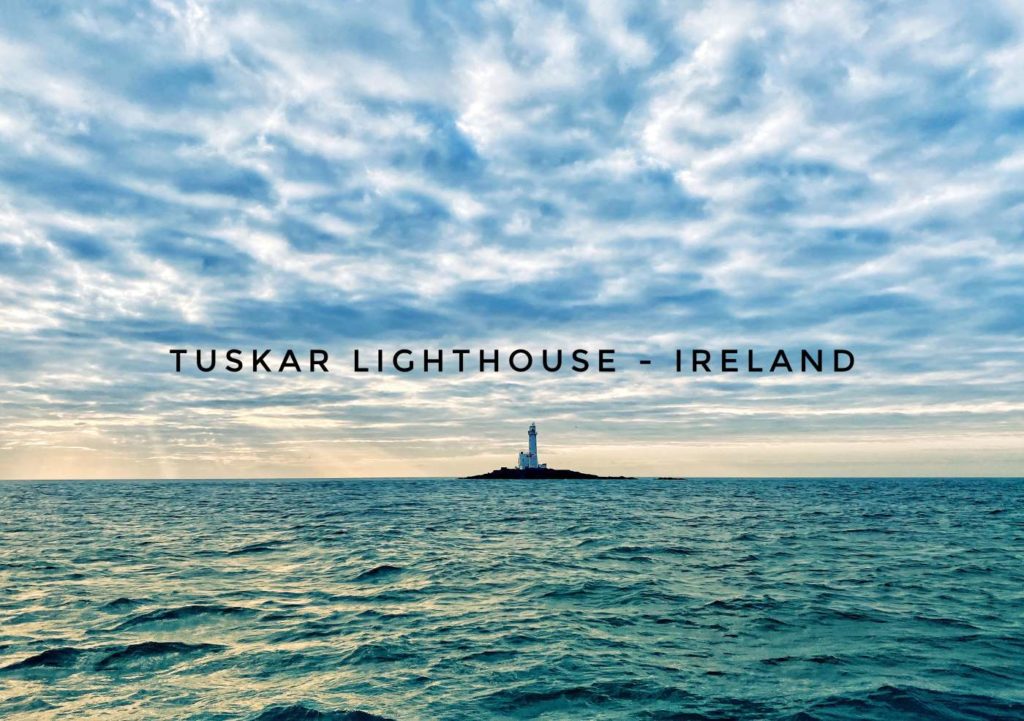
The winds were forecast to build again as we steadily progressed North, this time with a wind direction from the North West, as the next Atlantic low bore its way through the south of Iceland.
Our plan to wait out in the Helford River and to cross the Bristol Channel in light winds had paid off. As the winds increased in the approaches to Dublin, we were grateful for the shelter that the Irish green and beautiful coast provided.
We entered Dublin Bay passing through the narrow sound between Dalkey Island and Sorrento Point just as the evening light illuminated Dun Laoghaire and the chimneys of Dublin beyond.
Never has Dublin looked so close and inviting, but with a strict lockdown in place, we were sadly unable to stop.

Indeed, as we crossed Dublin Bay, we were met by the local Pilot Boat and after communicating with the VTS Operations, were allowed to continue into the night, sheltering from the strengthening winds close to shore.
Just after I fell asleep as I came off watch around 10 pm, my crew woke me as they slowed the vessel and woke me to advise we were being approached by Customs and Border vessels. Sure enough, two vessels were chasing us down under blue lights and soon after, boarded us to question our intentions.
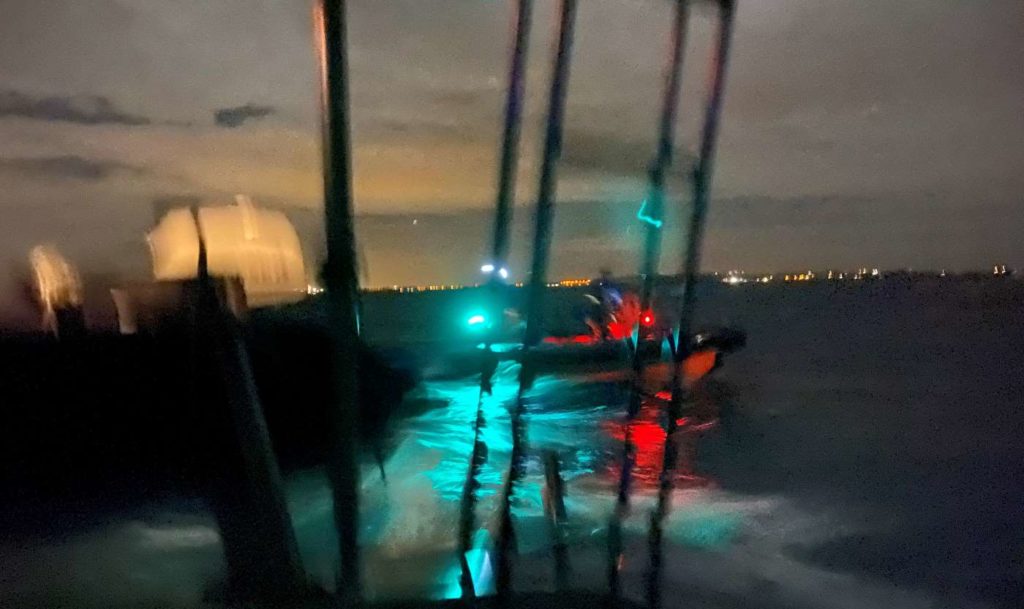
We continued toward the Northern Irish border under reduced power as the officers questioned us, checked our documentation and carried out a search of the vessel.
They relaxed after a while and radioed through to base to ask for verification of our story and if we should be allowed to continue. After some 2 hours and close to Strangford Loch, they finally left us to re-join their accompanying vessels with their blessings.
A friendly voice
During the Small hours, whilst I was back on watch, I had an interesting conversation over the VHF, with the skipper of an Irish fishing vessel heading out to the fishing grounds.
We had elected to do the “right thing” (even though we were a stand-on vessel), altering course to allow him safe passage and the skipper appreciated the gesture and filled me in on the restrictions that were being implemented ashore.
He complimented us on our timing with the tides for the passage ahead, which had been a feature of our journey now since passing Oussant Lighthouse on the north coast of Brittany and he confirmed that we should expect a favourable push all the way up the Scottish coast, with following winds to boot.
At dawn, with winds backing to the South East and easing, we broke free of the welcome shelter provided Northern Irish Coast and set our sights on the short hop over to the Scottish Coast.
Savouring the taste of things to come, we enjoyed bacon sandwiches together for breakfast and all remained on the bridge for the rest of the day.
It’s in her soul
Lotre Moun (or now she was back in home waters, should I now refer to her as Otters Moon again?) seemed to sense she was close to home and plodded away with a new spring in her step!
Under April skies, we managed to avoid the worst of the showers, but they were just enough to clear the Pilothouse windows from the worst of the salt that he had accumulated since leaving the Helford River.
The wide outer reaches of the Clyde are protected by the majestic basalt bastion of Ailsa Craig and this slowly loomed out of the enveloping mists as we approached. We came within a stone’s throw of this amazing island and witnessed 1000’s of gannets on their nests and fishing off its coast.
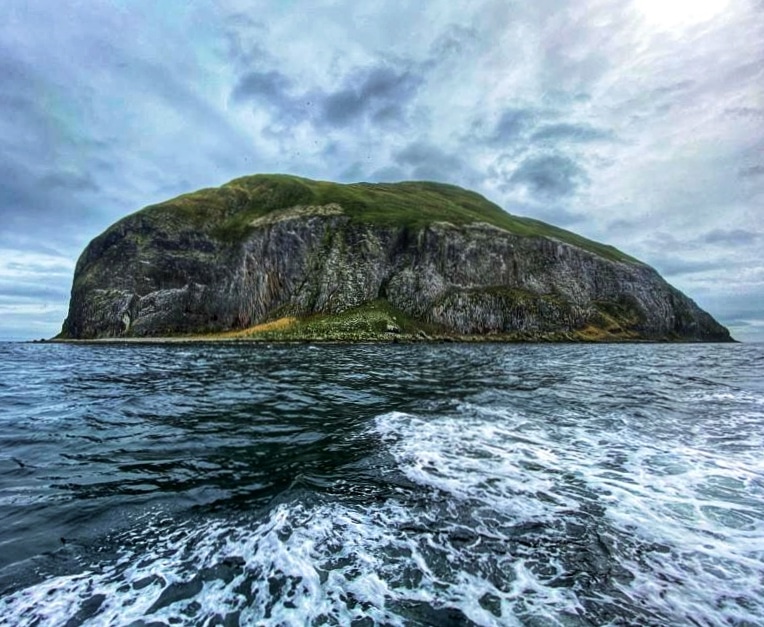
Later we passed between Arran and Holy Island, savouring the greens and beautiful buildings, sheltered in the bays with the mountains and rainclouds providing a dramatic backdrop.
Almost home, as we spoke with Clyde VTS and entered the narrows between the islands of Cumbrae. We made a perfect landfall, just as the sun was setting.
A phone call to the vessels owner, who was filled with pride having seen us pass close to his house in Greenock made a very satisfying end to the day.
Curfews and curlews
Having packed and carried out a thorough tidy the night before, we had made arrangements for a vehicle to be left securely for us at James Watt Marina well ahead of our arrival. We awoke before dawn and transferred all our personal belongings across to the vehicle, leaving one of our crew to drive round to Gareloch, whilst we took the boat across to leave her on anchor (saving us the job of transferring things across in the tender).
As we approached Gareloch, the Police and Royal Navy guard vessels moved away, allowing us entry. The scene was perfect. Some remnants of snow on the surrounding mountains and a mirror-calm loch, with reflections and that special intense morning light that is exaggerated by our latitude.
Silvers Marine occupies a sheltered and commanding site near Loch Gareloch’s entrance. We tied Otters Moon to one of the deepwater mooring buoys that would normally be occupied at this time of year, but we had our pick, being the only vessel on the loch.
Putting her trusty Gardner to rest, and turning off all the breakers, the silence was broken by the sound of Curlews, who seemed to be welcoming Otters Moon back home.
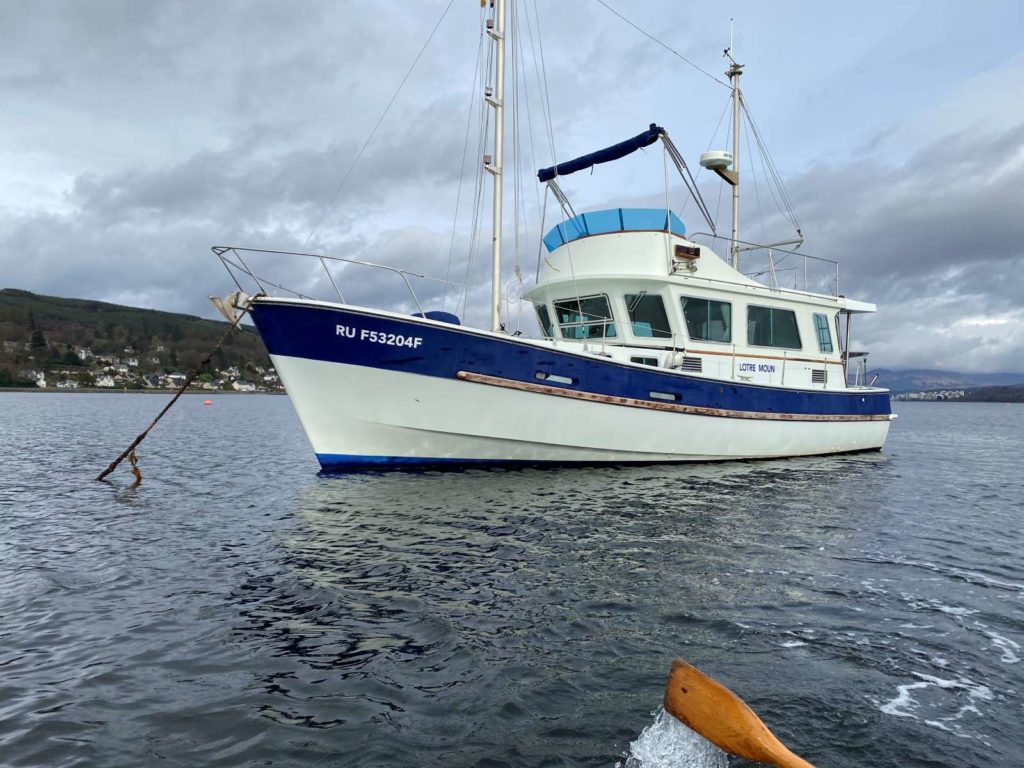
After checks and stowing, we locked up and made the short row ashore in Otters Moons tender, tying it up to one of the workboats as agreed, for the yard to deal with when they could return to work.
As we left the marina for the short drive past Faslane Naval base on to a closed Glasgow airport to make a prearranged transfer to a rental car to drive south, Otters Moon’s owners called us again, to tell us just how much it meant to him and what a wonderful achievement it was to get her back home in such challenging times.
He had apparently seen us leave and pass his house again that morning and had been contacted by friends, excitedly telling him that his father’s boat was finally back home where she belonged. What a superb chapter in what proved to be an epic journey in challenging circumstances.

With highly qualified and experienced crew, Halcyon Yachts Ltd offers a dedicated international yacht delivery service. For more information or to see details of their recent deliveries please visit
